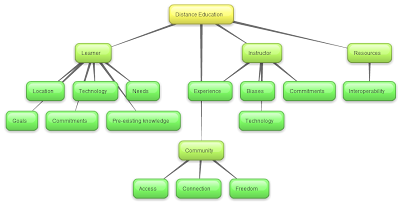What are some of the pre-planning strategies the trainer needs to consider before converting his program?
As the trainer begins planning for the conversion, it is important that they consider who the learners are, as well as the objectives that the training is setting out to address. With these in mind, the trainer should work to ground the delivery in a distance education theory. According to Dr. Saba (n.d.), theory serves as a guide or a map to help practice. Equivalency theory is a practical place to start, which focuses on learning outcomes. The goal is not to create an identical experience to the classroom experience, but to provide an equivalent learning experience to meet those outcomes (Simonson, n.d.). In a training situation, where adults are the primary audience, Andragogy is also valuable to help understand the characteristics of learners as well as the characteristics of systems that will support their learning at a distance.
What aspects of his original training program could be enhanced in the distance learning format?
All aspects of the original training program should be looked at to see how they could be enhanced in a distance format. Beldarrain (2006) states that regardless of the delivery method, technology should:
(1) Encourage contact between students and faculty.
(2) Develop reciprocity and cooperation among students.
(3) Use active learning techniques.
(4) Give prompt feedback.
(5) Emphasize time on task.
(6) Communicate high expectations.
(7) Respect diverse talents and ways of learning.
How will his role, as trainer, change in a distance learning environment?
Generally, trainers are used to functioning in a “teacher-centered” model. A distance model which uses andragogy as the theoretical framework is however a “student-centered” model. The trainer needs to be prepared to move from simply delivering content, to facilitating learners in actively engaging and participating in the process (Simonson, Smaldino, Albright, & Zvacek, 2009).
What steps should the trainer take to encourage the trainees to communicate online?
The two primary things that a trainer can do to encourage trainees to communicate online are establishing a classroom culture that is conducive to learning and establish the rules of etiquette to be used within the online environment (Simonson, et al 2009).
Establishing a culture (or environment) that promotes respect and dignity for the adult learner is a key component of Andragogy (Simonson, et al 2009). The creation of the culture is the responsibility of all participants, but since students do tend to look to the trainer for leadership (Paz Dennen, V. 2005), the trainer does play an important role.
Particularly if learners are new to an online environment, it is important that they understand the complexity of the setting and how to participate in an appropriate manner. Adult learners need to feel supported and it is important that ground rules are established so comments are not directed toward a person (Simonson, et al 2009). The trainer plays a vital role in establishing and maintaining the etiquette of a classroom which will help ensure that all participants have the experience of being supported.
References
Beldarrain, Y. (2006). Distance education trends: Integrating new technologies to foster student interaction and collaboration. Distance Education, 27(2), 139–153.
Paz Dennen, v. (2005) From Message Posting to Learning Dialogues: Factors affecting learner participation in asynchronous discussion. Distance Education, 26 (1)127–148.
Saba, Theory and Distance Learning [Video] (n.d.)
Simonson, M., Smaldino, S., Albright, M., & Zvacek, S. (2009). Teaching and learning at a distance: Foundations of distance education (4th ed.) Boston, MA: Pearson.







